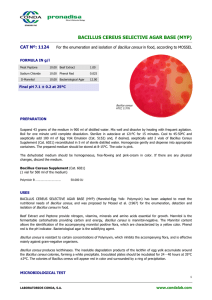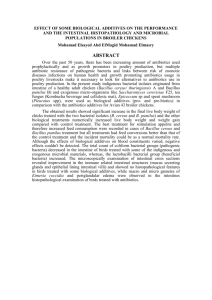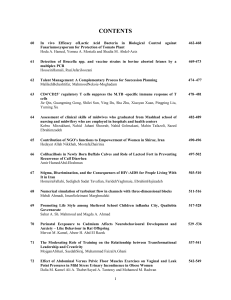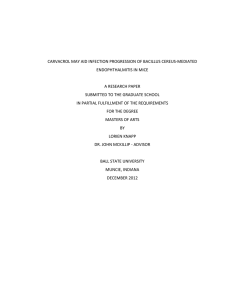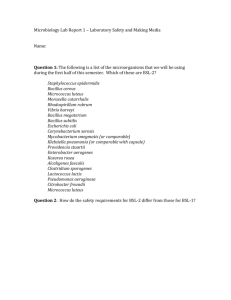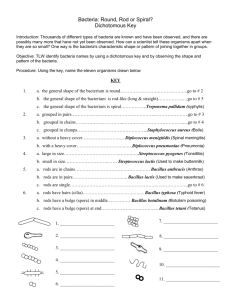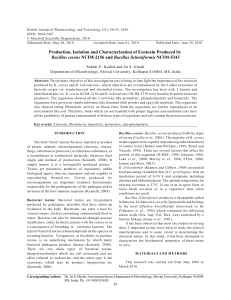Case #1
advertisement
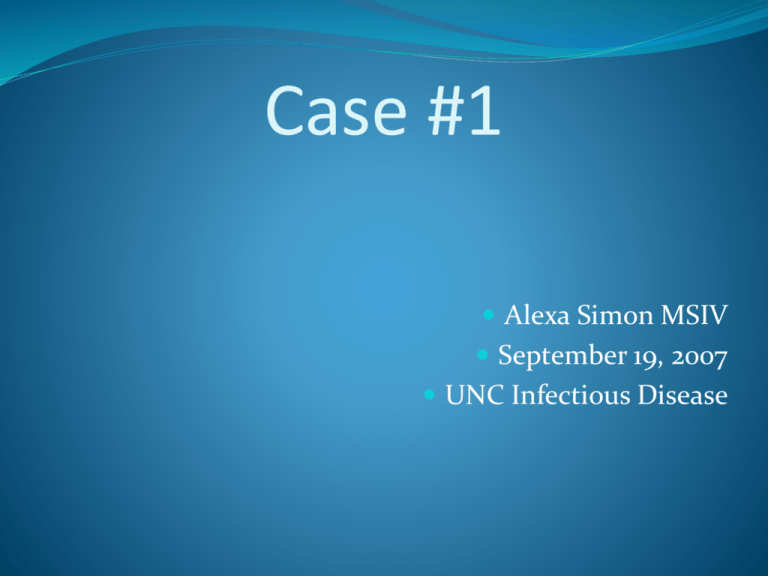
Case #1 Alexa Simon MSIV September 19, 2007 UNC Infectious Disease CC: Nausea vomiting, fever HPI: 56 y/0 AAF with history significant for ovarian cancer stage IIIC with a complicated surgical history including debulking surgery in 2005, ileocecal resection, and recent repair of enterocutaneous fistula presented to Johnston Memorial with acute onset of nausea, vomiting, fever and abdominal pain. HPI cont…. At JM she was found on CT scan to have fluid collection in the anterior subcutaneous tissue. She was started on Zosyn Patient was transferred to Gyn/Onc at UNC and started on Ceftazidine and Flagyl. HPI cont…. She progressively became more hypotension with increasing 02 requirements: Became obtunded and ID consult team was paged. The Ob/gyn resident ended phone call to ID saying “I need to go intubate the patient.” Tumor History Prior to 2005 was healthy 9/2005: Presents with abdominal pain CT with massive ascites and 2 large adnexal masses CA-125>300 9/29/2005: Ex-laporatomy BSO with iliocecal resection, Re-anastomosis omentectomy Suboptimal debulking mass PE with attempted VIR for embolectomy of saddle embolus Multiple MIs TPN dependence begins 12/2005: Chemotherapy began with Taxol 7/2007: Repair enterocutaneous fistula Infection History 10/2006: Candida albicans and coagulase negative staphylococcal infection at port site Rx: Fluconazole and daptomycin for 2 wks 11/2006: Candida parapsilosis fungemia Rx: Capsofungin with 8 wks 1/2007: Coagulase negative staphylococcal and ampicillin sensitive enterococcal bacteremia Rx: Daptomycin 3/07: Coagulase negative staphylococcal bacteremia Rx: Daptomycin 7/2007 coag negative staph line infection and UTIs with enterococci and candida Rx: Linezolid and fluconazole Additional History SH: Patient denies alcohol, tobacco, drugs Family History Mother had ovarian cancer Father had prostate cancer ROS: unobtainable due to intubation and sedation Additional History Meds Ceftazidine 2g IV q12 Flagyl 500mg q12 Linezolid 600mg q12 Micafungin 100 mg IV QD Dopamine GGT Morphine PRN Benadryl PRN Phenergan PRN Zofran PRN Allergies Zosyn: Rash Ace Inhibitors: Rash Vancomycin: Rash PCN: Rash Zofran: Rash Physical Exam Vitals: Tmax 36.8/Tc: 35.9 BP:110/58 P:87 CVP:14-17 Vent: SIMV PS:10 PEEP:5 FIO2%:40 TV 600 Rate 16 General: Intubated, withdraws from pain 6-7/T HEENT: Icteric, PERRLA, no LAD CV: RRR 2/6 holosystolic murmur, non radiating on left sternal border; no rubs or gallops Lungs: Crackles Bilaterally at bases Skin: jaundiced, no rash or bruising noted Abdomen: tender throughout, no rebound, hypoactive bowel sounds; multiple surgical scars, with palpable subcutaneous midline mass (not fluctuant) No hepatosplenomegaly appreciated Extremities: 1+ pitting edema bilaterally Labs: 9.2 20.7 51 27.5 Ca:7.4 Mg:1.9 GGT:122 Differential: ANC: 18.0↑ ALC:0.8 AMC: 0.8 AEC:0.2 ABC: 0 139 112 31 71 3.1 14 Phos:4.6 1.5 6.2 2.2 21.6 20.4 84 74 181 Radiology RUQ US: Lack visualized flow in portal veins/SMV, some echogenic material in portal veins concerning for clot Hepatomegaly New extrahepatic biliary ductal dilations CT Adomen/ Pelvis Radiology CTA Abdomen: Fluid collections contain focal area of gas with density within the soft tissues overlaying a anterior abdominal wall may represent abscess Increase in the size of multiple high density lesions seen in the liver, which contain calcifications. Low density fluid in pelvis collection with in abdomen c/w ascites Stable Left pleural effusion DISCUSSION……….. Her Results: Microbiology: Urine Culture: gram positive cocci in chains Blood Culture (peripheral and central line): GPCs in chains and GPRs Abdominal abscess: GPCs in chains TTE: Left Ventricle: hyperdynamic EF: 6570% Mitral Valve: thickened with mild prolapse, moderate regurgitation Aortic Valve: trileaflet with mild thickening Right Ventricle: normal Tricupsid Valve: mild thickening with mobile echo from the atrial surface consistent with degenerative, disease and vegetation, with mild regurgitation Pulmonary Valve: not well imagine Infectious Disease Diagnosis Bacteremia: Enterococci (ampicillin sensitive, but gentamicin R) Bacillus cereus Endocarditis of the tricuspid valve Antibiotics used: Imepenem/cilastin and daptomycin used to treat for 12 weeks B. cereus now… Bacillus cereus Commonly found in soil, inanimate objects, and mucus membranes healthy people Gram positive motile rods with paracentral spores Taxonomy of 3 groups: large cell subgroup, small cell, mixed Large group is B. anthracis and cereus They differ by fewer 9 nucleotides Bacillus cereus cont’d… Grows on blood agar as large flat, granular, ground glass, beta-hemolytic Grows aerobically and a facultative anaerobe Contains catalase, hemolysins, beta-lactamases, oxididase Ferments glucose, maltose, sucrose, trehalose Does not ferment lactose, xylose, mannitol Resistant to heat Motile Bacillus cereus Toxins Enterotoxin- can be necrotizing Emetic toxin- mitochondrial toxin Inhibits mitochondrial fatty-acid oxidation Can cause liver failure Phospholipases- release lysozyme enzymes (like alpha toxin c. perfringens) Proteases Hemolysins-causing cell lysis of leukocytes and macrophages Beta-lactamases thus resistant to most PCNs Bacillus cereus Infections 1: Local (burns, trauma, post op, fulminant eye infections) 2: Bacteremia/septicemia 3: CNS 4: Respiratory infection 5: Endocarditis, pericarditis 6: Food poisoning, toxin induced Increase in non-food poisoning in IVDU, neonates, malignancy, AIDs, prosthetic parts Most common form is GI intoxication from spores by enterotoxins Food-Poisoning Occurs 6-8hrs after ingesting B. cereus toxins Patients typically have significant emesis and less frequently diarrhea Enterotoxins : hemolysin, non-hemolytic enterotoxin, enterotoxin T, and cytotoxin K Emetic toxin No fevers because not systemic disease Commonly isolated from reheated foods Endophthalmitis 5/10,000 hospital patients 60% occur after intraocular surgery Often due to transient bacterial contamination by conjuctival flora 4-13% after penetrating trauma Once inoculated bacillus spreads through out whole eye If motile strain <12 hours to detect inflammatory reaction in the eye Symptoms: pain “ache”, redness, blurry vision, ring corneal infiltrate Loss retinal function in 18hours if fully virulent (pclR gene and motile) High morbidity with loss of vision in infected eye Phospholipases toxins responsible for the destructions Treatment is injection of antibiotics into the vitreous and vitrectomy, along with systemic antibiotics. 5 year Review of Cleveland Hospitals From: 1981-1986 38 patients with significant Bacillus infections: 78.9% bacteremia 1/3 IVDU or had indwelling catheters, 4 had cancer 30% IVDU 7.9% endopthalmitis 1.8% Endocarditis (only with IVDU) Osteomyelitis Visceral infection- significant morbidity 1 pneumonia and1 necrotizing fasciitis after trauma Medicine (Baltimore) 1987;66(3):218-23. 5 year Review continued… Intravascular device (pacemaker, central line) is a cause of the nosocomial bacillus bacteremia 4/38 patients improved after removal intravascular catheter with out antibiotics Endocarditis rare phenomenon with B. Cereus Overall patients with primary bacteremia recovered quicker and had less morbidity then patient with a localized infection Medicine (Baltimore) 1987;66(3):218-23. Bacillus spp. Among hospitalized patients with Haematological malignancies 3.4% bacteremic with bacillus spp. Most only presented with fever Few cases of pneumonia, GI/Hepatic symptoms Patients that are granulocytopenic are at risk for opportunistic infections with bacillus Many species can effect neutropenic patients which in clude B. licheniformis, B. cereus, B. pumilus All patient were bacteremic, only few had pneumonias, endocarditis, or localized infections Journal of Hospital Infections 2006.;64(2):169-76. Pseudo Epidemics Outbreaks have been seen in dialysis units, ICUs, neonatal ICUs Bacillus spores are sticky Non-sterile cotton wool Laundered linens including gowns, sheets Ventilation systems Dressings Hands Dairy plants- filling machines Korean dried red pepper Contaminated Transfusions Platelet transfusions: contaminated 0.08-0.7 % Stored at room temperatures, thus longer storage time increase risk of contamination Possible contaminants: dipthroid rods, coagulase negative staph, B. cereus, E. cloacae, E. coli, P. aeruginosa Most cases deteriorated with minutes of transfusion Leading to hospital outbreaks of infections More common with patients with hematological malignancy Second to transfusions or long term indwelling catheters Blood transfusions no data seen Treatment B. Cereus inherently resistant to most beta-lactams Antibiotics known to work: Imipenem Clindamycin In vitro activities of antibiotics on Bacillus spp and Spores Aminoglycosides: MIC 2-0.5 Doxycycline: MIC 0.5 Vancomycin: MIC 1 Erythromycin: MIC>16 Ciprofloxacin: MIC 0.25 Daptomycin: MIC 1 Journal of Clinical Microbiology 2006;44(10):3814-18 References te Boekhorst PA, et al. Clinical significance of bacteriologic screening in platelet concentrates. Transfusion 2005;45(4):514-19. Drobniewski FA. Bacillus cereus and related species. Clinical microbiology reviews 1993;6(4):324-38. Sliman R, et al. Serious infections caused by bacillus species. Medicine (Baltimore)1987;66(3):218-23. Rotman B, Cote MA. Application of real-time biosensor to detect bacteria in platelet concentrates. Biochemical and biophysical research communications 2003;300(1):197-200. Yomtovian R, et al. A prospective microbiologic surveillance program to detect and prevent the transfusion of bacterial contaminated platelets. Transfusion 1993;33(11):902-9. Guinebretiere MK, et al. Enterotoxigenic profiles of food-poisoning and foodborne bacillus cereus strains. Journal of Clinical Microbiology 2002;40(8):305356. References (cont’d.) Callegan M, et al. Bacillus endophthalmitis: Role of bacterial toxins and motility during infections. Investigative Ophthalmology and Visual Science 2005;46(9):3233-8. Citron DM, Appleman MD. In vitro activities of daptomycin, ciprofloxacin, and other antimicrobial agents against the cells and spores of clinical isolates of bacillus species. Journal of Clinical Microbiology 2006;44(10):3814-8. Mahler H, et al. Fulminant liver failure in association with the emetic toxin of bacillus cereus. NEJM 1997;336(16):1142-8. Ozkocaman V, et al. Bacillus spp. among hospitalized patients with haematological malignancies: clinical features, epidemics and outcomes. Journal of Hospital Infections 2006;64(2):169-76. Search PubMed Bacillus Cereus Bacteremia Case Reports Reviews Differential Diagnosis Drug Therapy




